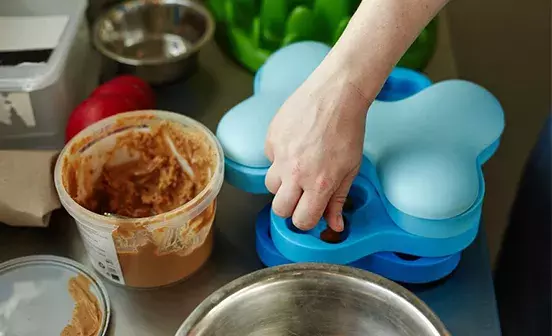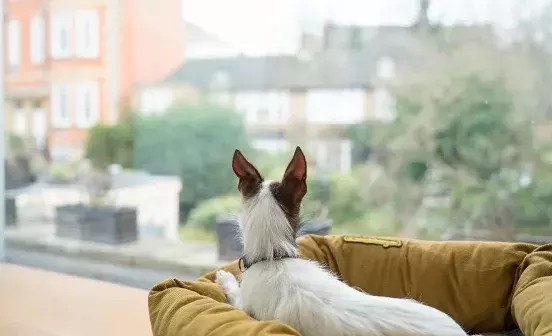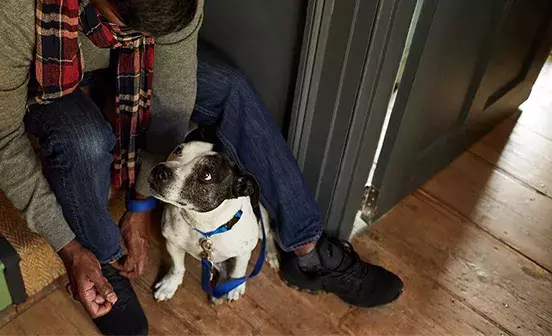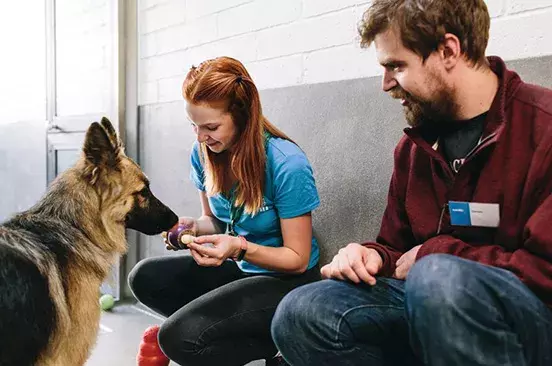Sometimes referred to as separation anxiety, some dogs can find being left on their own an overwhelming and stressful experience.
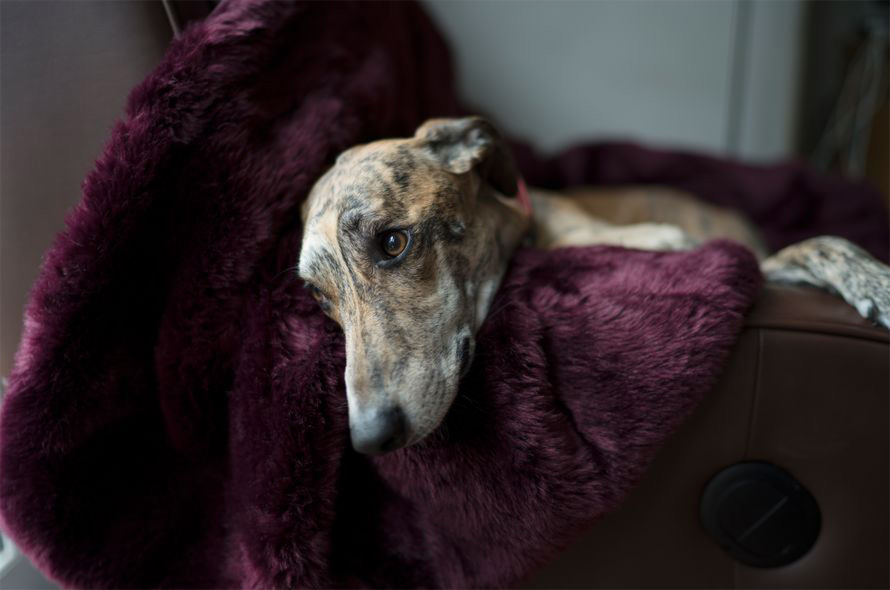
Separation-related behaviours can occur for several reasons and in order to successfully solve it, we must first understand what’s causing it.
Check out our video for to see our tips on how to help keep your dog relaxed when you’re not at home.
For some dogs, separation-related behaviours are simply a product of boredom due to lack of appropriate physical and mental stimulation. Whereas for other dogs, separation-related behaviours and anxiety are much deeper rooted. When a dog is emotionally attached to someone and that person goes away, it can cause fear, frustration, and anxiety. Over time, your dog might even start to anticipate the behaviour and the changes to their environment that lead up to that person leaving and may start showing their anxious behaviours before it happens.
Understanding the root cause of the problem and why your dog is reacting in this way will allow you to implement the right kind of training that will improve their behaviour in the long term and not just straight away.
It’s important to remember that each dog is an individual and will progress through training at different rates. Always aim to ensure you are working within your dog’s limits and that you are keeping a close eye on their stress levels. Recognising signs of stress and knowing how to manage stress levels is key in making sure that your dog is happy.
There are a number of signs that may show that your dog is stressed, which include:
- Excessive panting
- Tail between legs
- Lip licking
- Ears pinned back
- Paw raises
- Yawning
- Pacing
Here are a few tips to help you work through your dog’s separation-related anxiety behaviours.
Step 1 – Identify the cause of the anxiety
Identifying triggers for separation related behaviours can be difficult, as the majority of behaviour happens while your dog is on their own. If possible, set up a camera that allows you to see what your dog is doing when you’re not with them. This footage will allow you to more accurately identify any specific environmental triggers that may be contributing to your dog’s behaviour such as: the sound of people passing the house, loud cars and trucks or maybe even the sound of the neighbour’s dog barking.
Separation related problems often present themselves as a variety of different behaviours depending on the cause, so it is important to know exactly what to look out for.
Boredom
Dogs need both mental and physical stimulation in order to stay happy and healthy. If your dog isn’t getting enough physical and/or mental exercise this might be contributing to their behaviour. If your dog has lots of energy left to use up, then being left alone will probably be very difficult for them, much like it would for a human! As your dog runs out of constructive things to do you will begin to see that this energy is directed elsewhere and will often manifest as destructive behaviours such as digging and chewing.
Frustration
Frustration in dogs can be challenging to identify but is often triggered by a dog’s inability to get at something they want or need. To see if this might be the cause, keep an eye out for things that may be causing your dog to become frustrated. In some cases, your dog might be frustrated by catching sight of wildlife or cats parading outside the window that they desperately want to get to but can’t. In other dogs, if they feel like they suddenly don’t have their owner’s attention and comfort they might frantically try to find and recreate that comfort in some other way.
Fear and anxiety
Previous negative experiences can often have a big impact on future behaviour in dogs. For some dogs, if they’ve experienced something negative when left alone before, this can cause fear and anxiety in the future when spending time by themselves. With these types of separation related issues, you may see your dog exhibit a number of stress related behaviours as well as howling, barking and in some cases going to the toilet in the house. The majority of these behaviours will most likely be seen while you’re not there, however, you may notice that your dog begins to show them as you prepare to leave. Actions such as putting your coat on, or your shoes, and picking up keys can come to act as signals to your dog and may trigger the same response.
Step 2 – Start your training
To start with, you will need to find out how long your dog is happy to be left on their own. You can do this by leaving the room and shutting the door behind you or using a baby gate to prevent your dog from following you. Remember to pay close attention to your dog’s stress here and look out for any of the first signs that your dog may be struggling. Once you have identified how long your dog is happy to be alone for, you can begin to practice leaving them, using this amount of time as your starting point.
A key thing to remember is never to punish your dog for their anxieties or frustrations. Their behaviour may be your dog’s way of asking you for help. Punishing them may make the problem worse as they may also start to become anxious about you coming home.
Before beginning your separation training, there are a few things you can do to help set your dog up for success from the beginning:
- Ensure your dog is getting enough physical exercise. It is also important for dogs to interact with other dogs if they are comfortable doing so. Regular walks and social interaction will help reduce your dog’s energy levels and fulfil their exercise needs.
- Provide your dog with plenty of opportunities to forage for food and play throughout the day. Food toys such as: KONGs, snuffle mats, treat balls and search games are a great way to do this. This will give your dog an appropriate outlet for mental energy. For more inspiration on how to engage your dog’s mind, check out our advice about Brain Games for Dogs.
- All dogs should have a safe place set up somewhere where they can settle and relax when at home. Think about things that might trigger your dog when creating this area. If your dog is frustrated, it’s a good idea to set this up in a room that doesn't overlook the garden or roads. Fearful or anxious dogs may prefer a crate covered in a blanket. Your dog should always have free access in and out of their safe area, so if you’re using a crate always remember to keep the door open. For more information, read our advice on how to crate train your dog.
- Before you start training, make sure that your dog has had the opportunity to exercise and has been to the toilet. You should always do this before you leave your dog for any amount of time.
Once you are happy your environment is set up the right way for your dog, you can start working towards reducing their separation related behaviour issues:
- Start slow and simple and make sure to work within your dog’s limits. Don’t go over the time limit you established earlier on in the process. In the early stages you will most likely not actually be leaving the house but working on encouraging your dog to settle in other rooms instead.
- When you leave your dog, make sure they have something, or a few different things, like toys or a puzzle feeder to keep them occupied and provide them with mental stimulation. Give this to them in the room where you will be leaving them and make sure that they are interested and engaged with it before you start to leave.
- Once your dog is ready, remove yourself from the room. Try to avoid making too much of a fuss when leaving. You want leaving to be a normal everyday occurrence and show your dog that it’s not something they need to be concerned or stressed about.
- When you go back into the room, greet your dog with gentle verbal praise and try to encourage calm behaviour where possible. Try not to get your dog too excited when re-entering the room as you do not want to encourage any more over excitable stressed behaviours.
- Gradually build up the amount of time your dog is alone. You should increase the amount of time slowly and bit by bit, even minute by minute if necessary, over a period of a few days and weeks. Keep a close eye on your dog for signs of stress as you increase the time and go back to shorter amounts of time if it seems like your dog is starting to show signs that they’re unhappy.
- Once your dog is happy with you being in a different room for longer periods of time, you can begin to leave the house. At this point you can also start to introduce the process of putting on your shoes and picking up keys.
Step 3 – Build your dog's confidence
If your dog is fearful and anxious when left alone, it could be an issue with their confidence. Just like humans, the more we reward our dogs and boost their confidence the happier they will be to do things on their own.
You can help your dog to be less anxious about being left alone by engaging in some basic training to help increase their self-confidence. This could be teaching them fun new tricks or just practicing behaviours they already know such as sit, down and paw. Try to also reward any independent behaviour from your dog, rewarding them with gentle praise if they choose to settle themselves down somewhere away from you.
Step 4 – Encourage your dog to be independent
If your dog is especially anxious and struggles to be away from you even for short periods of time, you can work on teaching them to settle on their own. Teaching them this will help your dog become more independent in themselves and will help with further training in the future.
To do this, fill a food toy such as a KONG and place it by your feet while you are watching TV. Do this regularly over the space of a few weeks and gradually place it further away from you each time. This will teach your dog to settle down and engage in activities without you. When your dog is occupied with the food you should still go in and out of the room as normal.
If you are able, installing baby gates throughout the house will allow you to move from room to room without your dog always being able to follow. This will help in training your dog to remain calm when you are not nearby and can sometimes help by showing them that you are still in the house. You could also try scattering a few bits of your dog’s daily allowance of dry food on the floor when you leave a room, which will provide them with a distraction.
Remember that your dog may have learned these behaviours over a long period of time, depending on their age and situation so it’s important to remember that unlearning them will take time, and patience, and that every dog will be different. Slowly increase the amount of time you are leaving your dog, a minute at a time if necessary, remembering to leave lots of things to occupy them when you do, and eventually your dog will learn that you leaving is normal and not a cause for alarm or stress.
Download steps as a handy advice sheet and use it as a reminder to train regularly:
